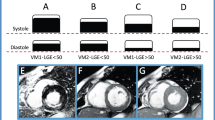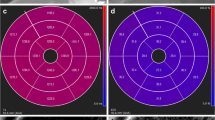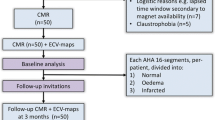Abstract
Objectives
We sought to determine whether the thickness of the non-contrast-enhanced myocardial rim (RIM) predicts recovery of territorial myocardial function after revascularization in chronic ischemic cardiomyopathy (ICM).
Background
Non-contrast-enhanced dysfunctional myocardium at late gadolinium-enhanced CMR depicts the presence of viable myocardium.
Methods
In 29 patients (65 ± 8 years) with ICM (EF 33 ± 10), ceCMR and cine images were acquired 5 ± 10 days before revascularization. Cine images were repeated after 6 months. Regional wall thickness, wall thickening and RIM were determined in each of 12 segments per short-axis slice (4–8/patient), which were assigned to the respective supplying coronary artery (LAD, LCX and RCA). A threshold for normal wall-thickening was derived from a control group (n = 14; 52 ± 17 years). Functional improvement at follow-up was defined as wall thickening >2 mm.
Results
Of the 1,896 analyzed segments, 655 segments showed severe dysfunction. At follow-up, 307 segments demonstrated functional improvement. The RIM differed between segments with and without improvement (6.6 ± 2.4 mm vs. 2.8 ± 2.0 mm; p < 0.0001). The area under the receiver operator characteristic (ROC) for predicting overall functional recovery was 0.91 (95%, CI 0.88–0.93, p < 0.001). A RIM of 4.0 mm predicted functional recovery after revascularization of the supplying coronary artery with a sensitivity and a specificity of 88 and 82% for the LAD, 96 and 86% for the RCA and 88 and 83% for the LCX, respectively.
Conclusion
RIM may be a useful marker for predicting territorial functional recovery after revascularization in patients with chronic ICM.




Similar content being viewed by others
References
Baer FM, Smolarz K, Theissen P, Voth E, Schicha H, Sechtem U (1994) Regional 99mTc-methoxyisobutyl-isonitrile-uptake at rest in patients with myocardial infarcts: comparison with morphological and functional parameters obtained from gradient-echo magnetic resonance imaging. Eur Heart J 15:97–107
Choi KM, Kim RJ, Gubernikoff G, Vargas JD, Parker M, Judd RM (2001) Transmural extent of acute myocardial infarction predicts long-term improvement in contractile function. Circulation 104:1101–1107
Dubnow MH, Burchell HB, Titus JL (1965) Postinfarction ventricular aneurysm. A clinicomorphologic and electrocardiographic study of 80 cases. Am Heart J 70:753–760
Gerber BL, Garot J, Bluemke DA, Wu KC, Lima JA (2002) Accuracy of contrast-enhanced magnetic resonance imaging in predicting improvement of regional myocardial function in patients after acute myocardial infarction. Circulation 106:1083–1089
Ichikawa Y, Sakuma H, Suzawa N, Kitagawa K, Makino K, Hirano T, Takeda K (2005) Late gadolinium-enhanced magnetic resonance imaging in acute and chronic myocardial infarction. Improved prediction of regional myocardial contraction in the chronic state by measuring thickness of nonenhanced myocardium. J Am Coll Cardiol 45:901–909
John AS, Dreyfus GD, Pennell DJ (2005) Images in cardiovascular medicine. Reversible wall thinning in hibernation predicted by cardiovascular magnetic resonance. Circulation 111:e24–e25
Kim RJ, Wu E, Rafael A, Chen EL, Parker MA, Simonetti O, Klocke FJ, Bonow RO, Judd RM (2000) The use of contrast-enhanced magnetic resonance imaging to identify reversible myocardial dysfunction. N Engl J Med 343:1445–1453
Knuesel PR, Nanz D, Wyss C, Buechi M, Kaufmann PA, von Schulthess GK, Luscher TF, Schwitter J (2003) Characterization of dysfunctional myocardium by positron emission tomography and magnetic resonance: relation to functional outcome after revascularization. Circulation 108:1095–1100
Kuhl HP, Lipke CS, Krombach GA, Katoh M, Battenberg TF, Nowak B, Heussen N, Buecker A, Schaefer WM (2006) Assessment of reversible myocardial dysfunction in chronic ischaemic heart disease: comparison of contrast-enhanced cardiovascular magnetic resonance and a combined positron emission tomography-single photon emission computed tomography imaging protocol. Eur Heart J 27:846–853
Kuhl HP, van der WA, Beek A, Visser F, Hanrath P, van RA (2006) Relation of end-diastolic wall thickness and the residual rim of viable myocardium by magnetic resonance imaging to myocardial viability assessed by fluorine-18 deoxyglucose positron emission tomography. Am J Cardiol 97:452–457
Matsuzaki M, Gallagher KP, Kemper WS, White F, Ross J Jr (1983) Sustained regional dysfunction produced by prolonged coronary stenosis: gradual recovery after reperfusion. Circulation 68:170–182
Mazeika PK, Nadazdin A, Oakley CM (1992) Dobutamine stress echocardiography for detection and assessment of coronary artery disease. J Am Coll Cardiol 19:1203–1211
Neizel M, Katoh M, Schade E, Rassaf T, Krombach GA, Kelm M, Kühl HP (2009) Rapid and accurate determination of relative infarct size in humans using contrast-enhanced magnetic resonance imaging. Clin Res Cardiol 98:319–324
Pasquet A, Robert A, D’Hondt AM, Dion R, Melin JA, Vanoverschelde JL (1999) Prognostic value of myocardial ischemia and viability in patients with chronic left ventricular ischemic dysfunction. Circulation 100:141–148
Pereira RS, Prato FS, Lekx KS, Sykes J, Wisenberg G (2000) Contrast-enhanced MRI for the assessment of myocardial viability after permanent coronary artery occlusion. Magn Reson Med 44:309–316
Pereztol-Valdes O, Candell-Riera J, Santana-Boado C, Angel J, Guade-Bruix S, Castell-Conesa J, Garcia EV, Soler-Soler J (2005) Correspondence between left ventricular 17 myocardial segments and coronary arteries. Eur Heart J 26:2637–2643
Perrone-Filardi P, Bacharach SL, Dilsizian V, Maurea S, Marin-Neto JA, Arrighi JA, Frank JA, Bonow RO (1992) Metabolic evidence of viable myocardium in regions with reduced wall thickness and absent wall thickening in patients with chronic ischemic left ventricular dysfunction. J Am Coll Cardiol 20:161–168
Samady H, Elefteriades JA, Abbott BG, Mattera JA, McPherson CA, Wackers FJ (1999) Failure to improve left ventricular function after coronary revascularization for ischemic cardiomyopathy is not associated with worse outcome. Circulation 100:1298–1304
Sandstede JJ, Lipke C, Beer M, Harre K, Pabst T, Kenn W, Neubauer S, Hahn D (2000) Analysis of first-pass and delayed contrast-enhancement patterns of dysfunctional myocardium on MR imaging: use in the prediction of myocardial viability. AJR Am J Roentgenol 174:1737–1740
Simonetti OP, Kim RJ, Fieno DS, Hillenbrand HB, Wu E, Bundy JM, Finn JP, Judd RM (2001) An improved MR imaging technique for the visualization of myocardial infarction. Radiology 218:215–223
Tamaki N, Kawamoto M, Tadamura E, Magata Y, Yonekura Y, Nohara R, Sasayama S, Nishimura K, Ban T, Konishi J (1995) Prediction of reversible ischemia after revascularization. Perfusion and metabolic studies with positron emission tomography. Circulation 91:1697–1705
Tillisch J, Brunken R, Marshall R, Schwaiger M, Mandelkern M, Phelps M, Schelbert H (1986) Reversibility of cardiac wall-motion abnormalities predicted by positron tomography. N Engl J Med 314:884–888
Wellnhofer E, Olariu A, Klein C, Grafe M, Wahl A, Fleck E, Nagel E (2004) Magnetic resonance low-dose dobutamine test is superior to SCAR quantification for the prediction of functional recovery. Circulation 109:2172–2174
Acknowledgments
This research project is being supported by the “Interdisciplinary Center for Clinical Research on Biomaterials and Tissue-Material-Interaction in Implants” (to HPK) and by the DFG (TR is a Heisenberg scholar of the DFG, RA 969/5-1).
Conflict of interest statement
None.
Author information
Authors and Affiliations
Corresponding author
Additional information
T. Rassaf, J. Nolte, and H. P. Kühl contributed equally to this work.
Rights and permissions
About this article
Cite this article
Rassaf, T., Nolte, J., Heussen, N. et al. Quantitation of the thickness of the non-enhanced myocardial rim predicts recovery of territorial myocardial function in chronic ischemic heart disease: a cardiac magnetic resonance imaging study. Clin Res Cardiol 99, 293–300 (2010). https://doi.org/10.1007/s00392-010-0117-y
Received:
Accepted:
Published:
Issue Date:
DOI: https://doi.org/10.1007/s00392-010-0117-y




